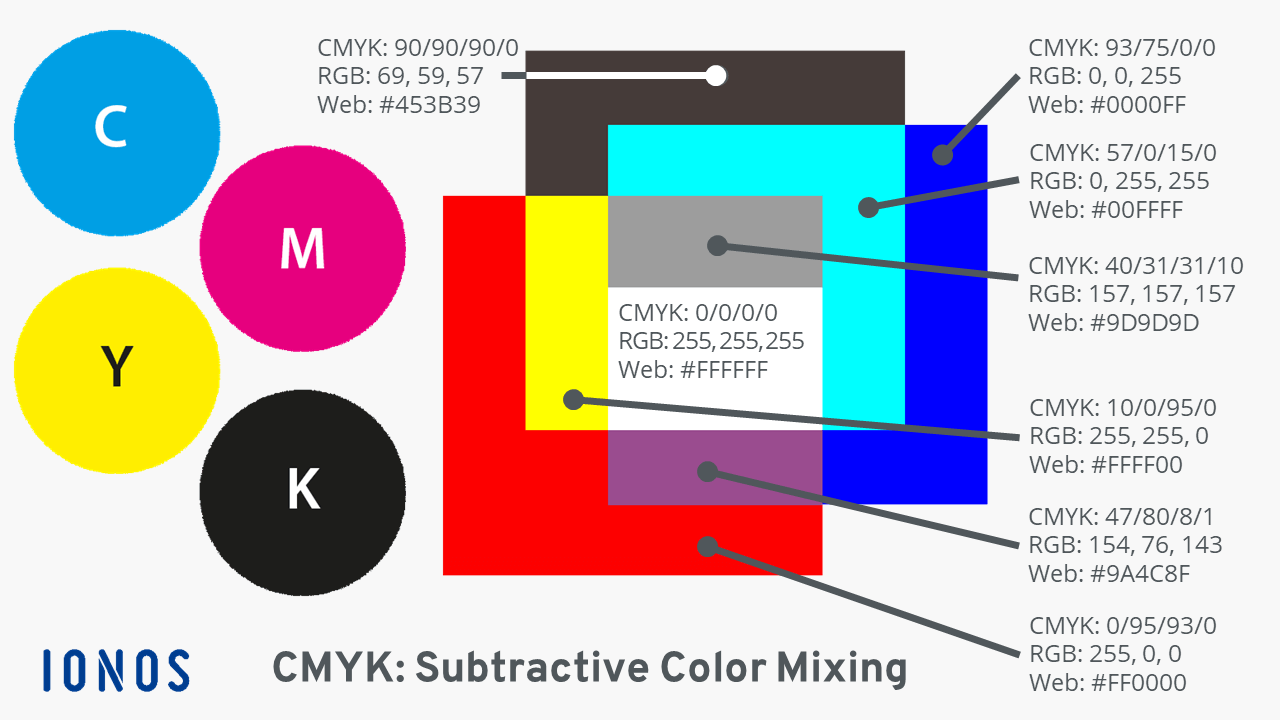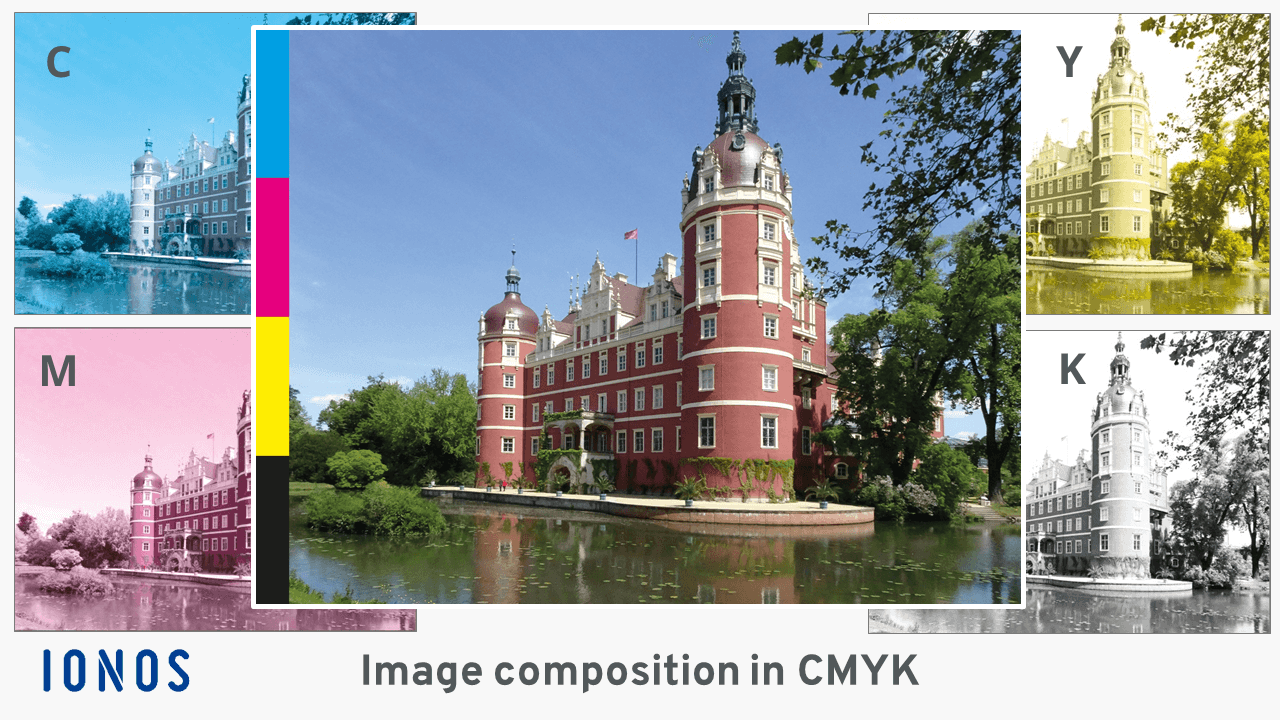CMYK Color Model explained
Printing colors has been possible since Gutenberg’s time, but the process of reproducing colored images for printed mass media, for example, was realized a few hundred years later. Standardized color scales have been around since 1915 with the Standard Color Reference of America. Today, many homes will own a color printer. But how does an RGB image get from the computer screen onto the printed paper? And why does it take four colors? We’ll show you what you need to know about CMYK colors and the differences to RGB and other color models.
- Simple registration
- Premium TLDs at great prices
- 24/7 personal consultant included
- Free privacy protection for eligible domains
How does CMYK work?
The use of colors for presenting on screen and in print follows the physical characteristics of the human eye. The eye is particularly sensitive to three light wavelengths. They are red, green, and blue and are used as part of the RGB color space. This ensures a color-balanced reproduction on color monitors.
During the printing process, however, white paper is usually printed on. Paper is not transparent and therefore doesn’t allow light to pass through. That’s why the four printing colors cyan, magenta, yellow, and black - CMYK - are applied one after the other in industrial offset color printing. The actual printing process is based on placing small, closely spaced dots which the human eye perceives as a color image once combined and viewed from a distance. To produce an adequate image quality, industrial offset printing usually requires 300 dots per inch (dpi). The tiny dots are of different sizes depending on the desired thickness of the color application. If a color component equals zero percent, there is no dot at this point and therefore no color.
Similarly, with color ink printers, tiny drops of ink are placed onto the paper in the shape of closely spaced dots. They range from 0.3 to 0.4 millimeters in size. It’s the sum of the individual droplets in the CMYK colors that creates the “illusion” of a colored image. A color laser printer delivers the same result, but in a slightly different way. There are four electrically charged drums, which are discharged by a laser beam where no toner should be released from one of the four CMYK cartridges. The remaining charged areas are then thinly coated with the colors. These coated print pixels are successively transferred to the paper and fixed by applying heat.
The three examples – offset, color ink and color laser printing – illustrate the demands on the precision of the printers. In the following, you’ll find out how colors are divided and used for this process.
How many colors does the CMYK space have?
The CMYK color space works with the basic colors cyan, magenta, and yellow. The letter K stands for “key” or “contrast” and denotes black. The “B” was already assigned for “Blue” in the RGB color space, so that it was no longer an option to denote as “Black”. CMYK colors are currently standardized according to ISO 2846 – a successor to the so-called Euroscale, which was bindingly specified in DIN 16539 from 1971.
CMYK belongs to the subtractive color models. To simplify, this means that if all colors are 100 percent active, the resulting color is black; if all colors are absent, i.e., at zero percent, (white) paper remains white. The intensity of different color nuances is comparable to mixing colors using a color box, for example, blue mixed with yellow results in green. Depending on the amount of water and color, a different shade of green is created.
The important difference to RGB: The absence of all three colors (RGB = 0, 0, 0) ensures black in the RGB color space. If red, green, and blue are each at their maximum value of 255, white is displayed. Being an additive color model, RGB is the exact opposite of CMYK.
In practice, it has been found that printing 100 percent cyan, magenta, and yellow results in a very dark shade of brown. In the figure above, this can be seen in the color field CMYK = 90/90/90/0. To create a true black, an additional component is needed. That is why the color black (K) has been included in the color space. At the same time, the addition of black made it easier to scale the other three colors. In theory, it’s possible to display up to four billion different color tones with CMYK colors.
CMYK and RGB – when to use each?
The CMYK color model is used when a representation of an image is physically output in the form of print media – i.e., using print machines of various technologies, and computer laser or inkjet color printers. In a four-color laser printer, three more ink cartridges are used in addition to black toner – cyan, magenta, and yellow. The same applies to color ink printers, although additional colors have been used for some time now. Given the higher demand on printed products, industrial printing machines have also been supplemented with additional color printing units. In six-color printing, they are green and orange. Other multicolor printing techniques use defined spot colors.
When is the RGB color model most useful? Find out more in our dedicated guide on RGB colors that reveals the secrets of additive color mixing in RGB and other color spaces.
RGB is always involved when something is displayed on screens or monitors. Digital cameras also produce RGB image files. With RGB, 16.8 million different color tones can be achieved.
What other color spaces are there?
Every printable medium, including every type of paper, reproduces colors slightly differently despite using the same CMYK values. Some absorb the ink more strongly, while others have a smooth, glossy surface, and others are matt. To compensate for this, standardized color profiles were created to ensure the same printing results are achieved for various types of paper and ink cartridges. An example of a color profile like this is the standardized color profile “ICC V4”.
Color profiles are available for scanners and monitors too to match colors across different technical devices for maximum color fidelity across different output media. The data sets for standardizing color management systems are coordinated by the International Color Consortium (ICC).
Color systems expand on this and define the composition of colors in greater depth. Some rely on theoretical models of color perception of the human eye.
CIELAB
The color system is also referred to as CIE-L*a*b* or Lab colors. It is based on the human perception of the so-called normal observer and includes all perceptible colors. It is not based on a mathematical model like RGB or CMYK. The underlying standard is EN ISO 11664-4 “Colorimetry – Part 4: CIE 1976 L *a*b* Color space”. This is often referred to as “tristimulus” in specialist articles.
HKS
The HKS color system currently consists of 88 basic colors and 3,520 full tone colors that can be used to print on natural and art paper. In contrast to CMYK, the colors are already pre-mixed before the printing process. The aim is an objective comparability and reproducibility of various color nuances. HKS colors can be simulated using CMYK, but a similar brilliance is rarely achieved.
Pantone
The Pantone Matching System is a color system that’s used internationally for graphics and print media. It was developed by US company Pantone and contains 1,867 specialist colors (as of 2016) that cannot be displayed using conventional four-color printing.
RAL
The RAL Classics color system from 1927 comprises 213 colors. The RAL design system with 1,625 standardized colors has existed since 1993. Some RAL colors are corporate colors or signal colors for certain items, e.g., b. RAL 3024 is used to paint fire and rescue vehicles, rescue cruisers, and lifeboats. The true-to-color representation of RAL colors is not uniformly possible on monitors and printers and is only approximated when using CMYK or RGB color specifications.
Find out more about the use of colors and image formats in our guides “What is a pixel”, “Ten image formats in overview” and “What’s TIFF? An introduction”.



